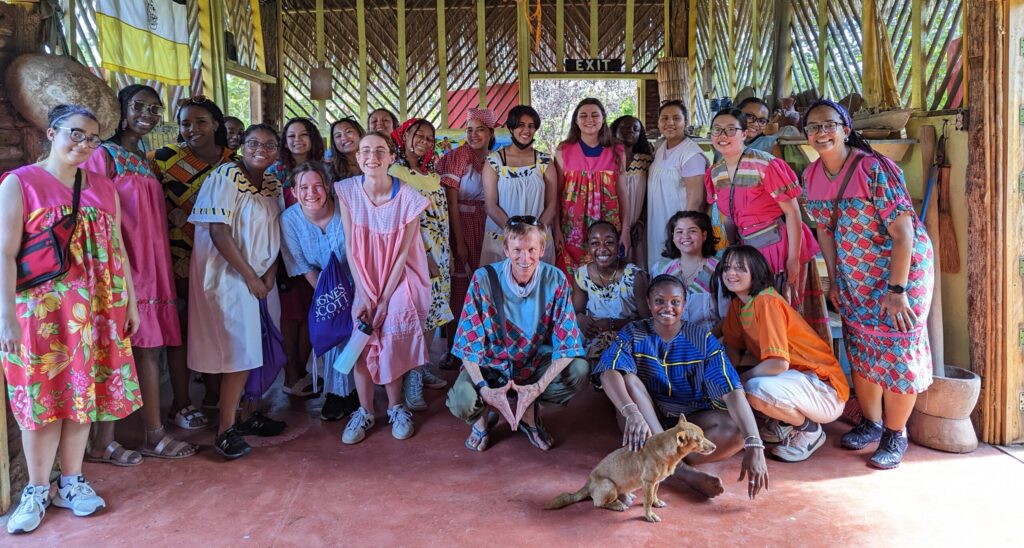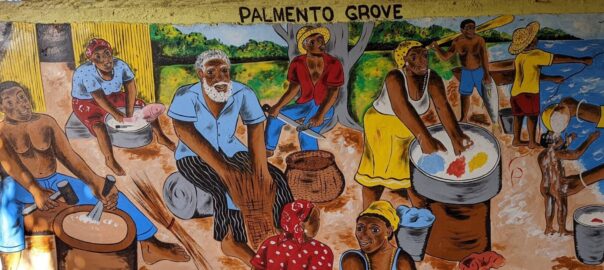Neocolonialism can be described as the subtle propagation of socio-economic and political activity by former colonial rulers aimed at reinforcing capitalism, neo-liberal globalization, and cultural subjugation of their former colonies. –Oseni Taiwo Afisi, Lagos State University, Nigeria
Our Agnes Scott College Global Journeys class, with expert guidance and planning provided by Learn from Travel, visited Belize in March 2022, just as three countries (Belize, Jamaica, and the Bahamas) united in a coalition aimed at removing the British Queen as head of state in each country and seeking reparations for generations of colonial oppression. A week after we returned (on March 13), an official Royal visit to Belize (by the Duke and Duchess of Cambridge) was disrupted by the refusal of a Mayan community to allow the Royals to visit Akte ‘il Ha cacao farm in Indian Creek village. Mayan vіllаgеrѕ have traditionally uѕеd this land for their livelihood, but they have been prohibited from using it by the conservation group Flоrа аnd Fаunа Іntеrnаtіоnаl (the dukе іѕ а раtrоn оf FFI).
 Members of the Global Journeys class in traditional Garifuna dress: Belize class. Back row, left to right: Miranda Hodgson-Weed; Trinity Duffie; Kiani London; Fiore Sturdivant; Mayra Martinez; Jill Samiano; Aurelia VanderWilde; Noelle Allen; Destinee Star-Serrao; Ty Kakkad; Melia Philips; Kelsey Houston; Leslye Alvarez-Gamez; Jingyu Zhang; Chakeria Harris; Learn from Travel guide Suyen Macado. Front row: Olivia Joyner; Sammie Gautreaux; Marigny Beter; Professor James Diedrick; Danielle Roberts; Bailee Deshong; Bianca Careaga; Ava Li-Kennedy.
Members of the Global Journeys class in traditional Garifuna dress: Belize class. Back row, left to right: Miranda Hodgson-Weed; Trinity Duffie; Kiani London; Fiore Sturdivant; Mayra Martinez; Jill Samiano; Aurelia VanderWilde; Noelle Allen; Destinee Star-Serrao; Ty Kakkad; Melia Philips; Kelsey Houston; Leslye Alvarez-Gamez; Jingyu Zhang; Chakeria Harris; Learn from Travel guide Suyen Macado. Front row: Olivia Joyner; Sammie Gautreaux; Marigny Beter; Professor James Diedrick; Danielle Roberts; Bailee Deshong; Bianca Careaga; Ava Li-Kennedy.
Since one of the learning goals for this course is “to reflect on the different impacts of globalization and inequalities on dominant and marginalized cultures,” these developments put the focus of our trip into sharp relief. We spent most of our time in the Stann Creek region of southern Belize, visiting with leaders of two minority groups: the Garifuna and Maya. This included days spent at both the Palmento Cultural Center, hearing from Garifuna activist Uwahnie Martinez (as well as her father Eugene), and in the village of Maya Centre, learning from Yucatec Maya healer Aurora Garcia Saqui. Both women embody the richness and vibrancy of their respective cultures, and pointedly expressed the challenges they face as members of minority groups in a post-colonial but decidedly neocolonial country.
The two majority ethnic groups in Belize are the Creoles (Kriols) and Mestizos. The Creoles are primarily descendants of enslaved sub-Saharan Africans, originally brought to Belize by English and Scottish log cutters, known as the Baymen. The Mestizos were originally immigrants from Mexico who brought the Spanish language and Catholicism with them, but in recent years this group has grown to include immigrants from all over Central America. While the Mestizo population is increasing (it now represents over half the population of the country), the Creole population is on the decline, now representing just a quarter of the citizenry.
During the 19th century, the British demonized and marginalized the free Garifuna, while claiming that the lives of the enslaved Creoles were better than those who shared their African descent. For a discussion of the legacy of colonialism in perpetuating the tension between the Garifuna and Creoles, see this discussion on the Belize television network, via YouTube–“Cultural Relations in Belize: The Creole-Garifuna Conflict.”
The essays and blogs on this site were written by the professor of this course, James Diedrick, and enrolled students. Current essays:
- Identity and Privilege, by Aurelia VanderWilde
- Awakening in Belize, by Miranda Hodgson-Weed
- “I for you, and you for me,” by Noelle Allen
- Can we transcend tourism? by Sammie Gautreaux
- Spirituality and Colonial Resistance in India and Belize, by Ty Kakkad
- Why does the Belize-Guatemala Territorial Dispute Matter?, by Aurelia VanderWilde
- “These Sons [and Daughters] of Freedom,” by James Diedrick
- “Visiting Sabal’s Cassava Farm,” by James Diedrick
- “Visiting the Belize Zoo, Remembering Sharon Matola,” by James Diedrick
Suggestions for further reading:
Barcott, Bruce. The Last Flight of the Scarlet Macaw: One Woman’s Fight to Save the World’s Most Beautiful Bird. Random House, 2008.
Although Barcott’s journalistic account focuses primarily on Belize Zoo founder Sharon Matola and the controversy over the Chalillo dam project on the Macal River, he also provides a running commentary on how Belize’s colonial legacy is still influencing politics and environmental debates in the country.
Bolland, Nigel O. Colonialism and Resistance in Belize: Essays in Historical Sociology. Belize City: Productions, 2003.
From Charles Rutheiser’s review in New West Indian Studies. . . : “A compilation of essays by one of the more prolific scholars working in Belize, this is ‘…not just another ‘history of Belize’ (p. 2). Rather, Bolland has chosen to investigate in depth a limited number of key topics, with the aim of setting some guideposts for further forays into the Belizean past. The nine essays cover a wide range of material: from the structure of eighteenth-century social relations and the distinctiveness of Belizean slavery to British-Maya relations, post-emancipation labor practices, and the problems of national integration in the post-colonial period” (p. 198).
Bolland, Nigel O. The formation of a colonial society : Belize, from conquest to Crown Colony. Ph.D. Thesis, University of Hull, 1995. [Downloadable PDF]
Abstract: “The purpose of the thesis is to examine the socioeconomic development of the British Settlement at Belize in its formative period from the seventeenth century to the establishment of Crown Colony rule in 1871. The connections between the political economy and the social structure of the Settlement are the primary focus of the study.”
Hogan, Dennis. “Britain in Latin America.” Oxford Bibliographies online; last modified 12 January 2022. [paid subscription required for full access]
From the Introduction: “In the 19th century, foreigners had unprecedented access to Spanish America, as the newly independent nations welcomed travelers as readily as they accepted foreign loans and investment capital. Britons were able to freely travel into the South American interior, and commercial ties between Britain and Latin America grew quickly. Cultural and economic exchanges proceeded in two major waves: the first occurred during and in the immediate aftermath of the Wars of Independence, and then, after a cooling-off period, during the second half of the century, when infrastructural and technological advances opened up the Latin American hinterlands to capitalist expansion. International trade grew after 1850, along with Britain’s role in Latin American culture. Britain remained the hegemonic foreign power in Latin America until the First World War. These relationships left their mark on both British and Latin American literatures.”
Lewis, Karla. “Colonial Education: A History of Education in Belize,” presented at the Annual Meeting of the American Educational Research Association, New Orleans, April 24-28, 2000.
Abstract: “this paper discusses education in Belize (formerly known as British Honduras) during the colonial era and the lasting impact of the educational foundation of the country. It examines the influence the British colonial educational system continues to have in Belize, 20 years after independence. It gives an overview of the history of primary and secondary education in Belize. Although education existed in Belize well before the arrival of the British colonizers and developed among various cultures during colonization, these are not highlighted in the paper because of the limited impact they had on Belize in general once school attendance became compulsory.”
Shoman, Assad. A History of Belize in Thirteen Chapters. Second Edition. Belize City: Angelus Press, 2011.
Explaining his approach in this book, Assad quotes an African proverb: “Until lions have their own historians, histories of the hunt will always glorify the hunter. I have tried to tell the story with the lions in mind, the majorities who endured oppression and exploitation and survived and passed on to their children the will to struggle. Wherever possible, I have used their own voices and always I have tried to show that whatever glory there is is theirs.”
